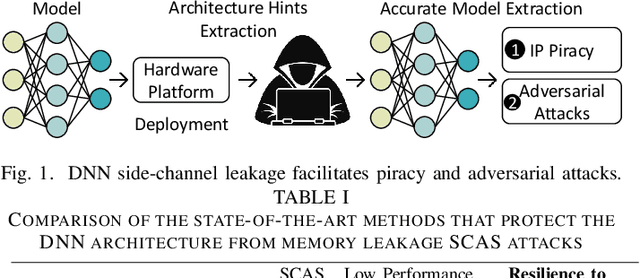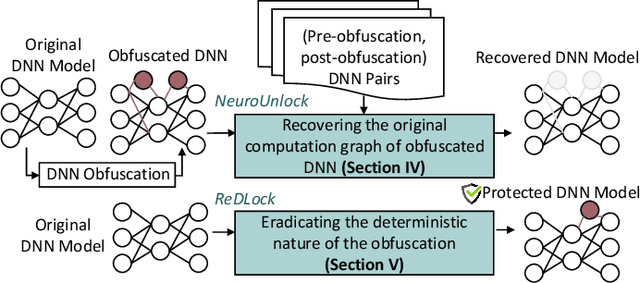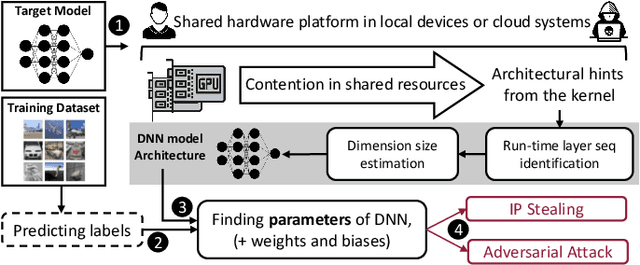Ozgur Sinanoglu
VeriLeaky: Navigating IP Protection vs Utility in Fine-Tuning for LLM-Driven Verilog Coding
Mar 17, 2025Abstract:Large language models (LLMs) offer significant potential for coding, yet fine-tuning (FT) with curated data is essential for niche languages like Verilog. Using proprietary intellectual property (IP) for FT presents a serious risk, as FT data can be leaked through LLM inference. This leads to a critical dilemma for design houses: seeking to build externally accessible LLMs offering competitive Verilog coding, how can they leverage in-house IP to enhance FT utility while ensuring IP protection? For the first time in the literature, we study this dilemma. Using LLaMA 3.1-8B, we conduct in-house FT on a baseline Verilog dataset (RTLCoder) supplemented with our own in-house IP, which is validated through multiple tape-outs. To rigorously assess IP leakage, we quantify structural similarity (AST/Dolos) and functional equivalence (Synopsys Formality) between generated codes and our in-house IP. We show that our IP can indeed be leaked, confirming the threat. As defense, we evaluate logic locking of Verilog codes (ASSURE). This offers some level of protection, yet reduces the IP's utility for FT and degrades the LLM's performance. Our study shows the need for novel strategies that are both effective and minimally disruptive to FT, an essential effort for enabling design houses to fully utilize their proprietary IP toward LLM-driven Verilog coding.
VeriContaminated: Assessing LLM-Driven Verilog Coding for Data Contamination
Mar 17, 2025Abstract:Large Language Models (LLMs) have revolutionized code generation, achieving exceptional results on various established benchmarking frameworks. However, concerns about data contamination - where benchmark data inadvertently leaks into pre-training or fine-tuning datasets - raise questions about the validity of these evaluations. While this issue is known, limiting the industrial adoption of LLM-driven software engineering, hardware coding has received little to no attention regarding these risks. For the first time, we analyze state-of-the-art (SOTA) evaluation frameworks for Verilog code generation (VerilogEval and RTLLM), using established methods for contamination detection (CCD and Min-K% Prob). We cover SOTA commercial and open-source LLMs (CodeGen2.5, Minitron 4b, Mistral 7b, phi-4 mini, LLaMA-{1,2,3.1}, GPT-{2,3.5,4o}, Deepseek-Coder, and CodeQwen 1.5), in baseline and fine-tuned models (RTLCoder and Verigen). Our study confirms that data contamination is a critical concern. We explore mitigations and the resulting trade-offs for code quality vs fairness (i.e., reducing contamination toward unbiased benchmarking).
ASCENT: Amplifying Power Side-Channel Resilience via Learning & Monte-Carlo Tree Search
Jun 27, 2024



Abstract:Power side-channel (PSC) analysis is pivotal for securing cryptographic hardware. Prior art focused on securing gate-level netlists obtained as-is from chip design automation, neglecting all the complexities and potential side-effects for security arising from the design automation process. That is, automation traditionally prioritizes power, performance, and area (PPA), sidelining security. We propose a "security-first" approach, refining the logic synthesis stage to enhance the overall resilience of PSC countermeasures. We introduce ASCENT, a learning-and-search-based framework that (i) drastically reduces the time for post-design PSC evaluation and (ii) explores the security-vs-PPA design space. Thus, ASCENT enables an efficient exploration of a large number of candidate netlists, leading to an improvement in PSC resilience compared to regular PPA-optimized netlists. ASCENT is up to 120x faster than traditional PSC analysis and yields a 3.11x improvement for PSC resilience of state-of-the-art PSC countermeasures
LLMs and the Future of Chip Design: Unveiling Security Risks and Building Trust
May 11, 2024Abstract:Chip design is about to be revolutionized by the integration of large language, multimodal, and circuit models (collectively LxMs). While exploring this exciting frontier with tremendous potential, the community must also carefully consider the related security risks and the need for building trust into using LxMs for chip design. First, we review the recent surge of using LxMs for chip design in general. We cover state-of-the-art works for the automation of hardware description language code generation and for scripting and guidance of essential but cumbersome tasks for electronic design automation tools, e.g., design-space exploration, tuning, or designer training. Second, we raise and provide initial answers to novel research questions on critical issues for security and trustworthiness of LxM-powered chip design from both the attack and defense perspectives.
TroLLoc: Logic Locking and Layout Hardening for IC Security Closure against Hardware Trojans
May 09, 2024Abstract:Due to cost benefits, supply chains of integrated circuits (ICs) are largely outsourced nowadays. However, passing ICs through various third-party providers gives rise to many security threats, like piracy of IC intellectual property or insertion of hardware Trojans, i.e., malicious circuit modifications. In this work, we proactively and systematically protect the physical layouts of ICs against post-design insertion of Trojans. Toward that end, we propose TroLLoc, a novel scheme for IC security closure that employs, for the first time, logic locking and layout hardening in unison. TroLLoc is fully integrated into a commercial-grade design flow, and TroLLoc is shown to be effective, efficient, and robust. Our work provides in-depth layout and security analysis considering the challenging benchmarks of the ISPD'22/23 contests for security closure. We show that TroLLoc successfully renders layouts resilient, with reasonable overheads, against (i) general prospects for Trojan insertion as in the ISPD'22 contest, (ii) actual Trojan insertion as in the ISPD'23 contest, and (iii) potential second-order attacks where adversaries would first (i.e., before Trojan insertion) try to bypass the locking defense, e.g., using advanced machine learning attacks. Finally, we release all our artifacts for independent verification [2].
ALMOST: Adversarial Learning to Mitigate Oracle-less ML Attacks via Synthesis Tuning
Mar 06, 2023Abstract:Oracle-less machine learning (ML) attacks have broken various logic locking schemes. Regular synthesis, which is tailored for area-power-delay optimization, yields netlists where key-gate localities are vulnerable to learning. Thus, we call for security-aware logic synthesis. We propose ALMOST, a framework for adversarial learning to mitigate oracle-less ML attacks via synthesis tuning. ALMOST uses a simulated-annealing-based synthesis recipe generator, employing adversarially trained models that can predict state-of-the-art attacks' accuracies over wide ranges of recipes and key-gate localities. Experiments on ISCAS benchmarks confirm the attacks' accuracies drops to around 50\% for ALMOST-synthesized circuits, all while not undermining design optimization.
Graph Neural Networks: A Powerful and Versatile Tool for Advancing Design, Reliability, and Security of ICs
Nov 29, 2022



Abstract:Graph neural networks (GNNs) have pushed the state-of-the-art (SOTA) for performance in learning and predicting on large-scale data present in social networks, biology, etc. Since integrated circuits (ICs) can naturally be represented as graphs, there has been a tremendous surge in employing GNNs for machine learning (ML)-based methods for various aspects of IC design. Given this trajectory, there is a timely need to review and discuss some powerful and versatile GNN approaches for advancing IC design. In this paper, we propose a generic pipeline for tailoring GNN models toward solving challenging problems for IC design. We outline promising options for each pipeline element, and we discuss selected and promising works, like leveraging GNNs to break SOTA logic obfuscation. Our comprehensive overview of GNNs frameworks covers (i) electronic design automation (EDA) and IC design in general, (ii) design of reliable ICs, and (iii) design as well as analysis of secure ICs. We provide our overview and related resources also in the GNN4IC hub at https://github.com/DfX-NYUAD/GNN4IC. Finally, we discuss interesting open problems for future research.
Security Closure of IC Layouts Against Hardware Trojans
Nov 15, 2022Abstract:Due to cost benefits, supply chains of integrated circuits (ICs) are largely outsourced nowadays. However, passing ICs through various third-party providers gives rise to many threats, like piracy of IC intellectual property or insertion of hardware Trojans, i.e., malicious circuit modifications. In this work, we proactively and systematically harden the physical layouts of ICs against post-design insertion of Trojans. Toward that end, we propose a multiplexer-based logic-locking scheme that is (i) devised for layout-level Trojan prevention, (ii) resilient against state-of-the-art, oracle-less machine learning attacks, and (iii) fully integrated into a tailored, yet generic, commercial-grade design flow. Our work provides in-depth security and layout analysis on a challenging benchmark suite. We show that ours can render layouts resilient, with reasonable overheads, against Trojan insertion in general and also against second-order attacks (i.e., adversaries seeking to bypass the locking defense in an oracle-less setting). We release our layout artifacts for independent verification [29] and we will release our methodology's source code.
GNN4REL: Graph Neural Networks for Predicting Circuit Reliability Degradation
Aug 04, 2022



Abstract:Process variations and device aging impose profound challenges for circuit designers. Without a precise understanding of the impact of variations on the delay of circuit paths, guardbands, which keep timing violations at bay, cannot be correctly estimated. This problem is exacerbated for advanced technology nodes, where transistor dimensions reach atomic levels and established margins are severely constrained. Hence, traditional worst-case analysis becomes impractical, resulting in intolerable performance overheads. Contrarily, process-variation/aging-aware static timing analysis (STA) equips designers with accurate statistical delay distributions. Timing guardbands that are small, yet sufficient, can then be effectively estimated. However, such analysis is costly as it requires intensive Monte-Carlo simulations. Further, it necessitates access to confidential physics-based aging models to generate the standard-cell libraries required for STA. In this work, we employ graph neural networks (GNNs) to accurately estimate the impact of process variations and device aging on the delay of any path within a circuit. Our proposed GNN4REL framework empowers designers to perform rapid and accurate reliability estimations without accessing transistor models, standard-cell libraries, or even STA; these components are all incorporated into the GNN model via training by the foundry. Specifically, GNN4REL is trained on a FinFET technology model that is calibrated against industrial 14nm measurement data. Through our extensive experiments on EPFL and ITC-99 benchmarks, as well as RISC-V processors, we successfully estimate delay degradations of all paths -- notably within seconds -- with a mean absolute error down to 0.01 percentage points.
NeuroUnlock: Unlocking the Architecture of Obfuscated Deep Neural Networks
Jun 01, 2022



Abstract:The advancements of deep neural networks (DNNs) have led to their deployment in diverse settings, including safety and security-critical applications. As a result, the characteristics of these models have become sensitive intellectual properties that require protection from malicious users. Extracting the architecture of a DNN through leaky side-channels (e.g., memory access) allows adversaries to (i) clone the model, and (ii) craft adversarial attacks. DNN obfuscation thwarts side-channel-based architecture stealing (SCAS) attacks by altering the run-time traces of a given DNN while preserving its functionality. In this work, we expose the vulnerability of state-of-the-art DNN obfuscation methods to these attacks. We present NeuroUnlock, a novel SCAS attack against obfuscated DNNs. Our NeuroUnlock employs a sequence-to-sequence model that learns the obfuscation procedure and automatically reverts it, thereby recovering the original DNN architecture. We demonstrate the effectiveness of NeuroUnlock by recovering the architecture of 200 randomly generated and obfuscated DNNs running on the Nvidia RTX 2080 TI graphics processing unit (GPU). Moreover, NeuroUnlock recovers the architecture of various other obfuscated DNNs, such as the VGG-11, VGG-13, ResNet-20, and ResNet-32 networks. After recovering the architecture, NeuroUnlock automatically builds a near-equivalent DNN with only a 1.4% drop in the testing accuracy. We further show that launching a subsequent adversarial attack on the recovered DNNs boosts the success rate of the adversarial attack by 51.7% in average compared to launching it on the obfuscated versions. Additionally, we propose a novel methodology for DNN obfuscation, ReDLock, which eradicates the deterministic nature of the obfuscation and achieves 2.16X more resilience to the NeuroUnlock attack. We release the NeuroUnlock and the ReDLock as open-source frameworks.
 Add to Chrome
Add to Chrome Add to Firefox
Add to Firefox Add to Edge
Add to Edge